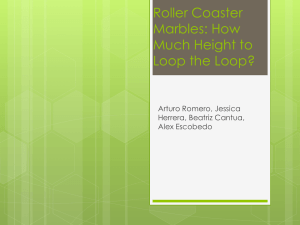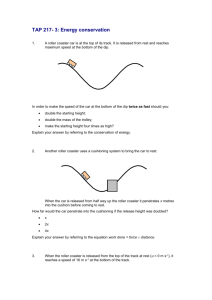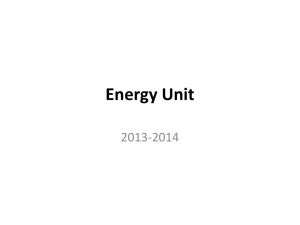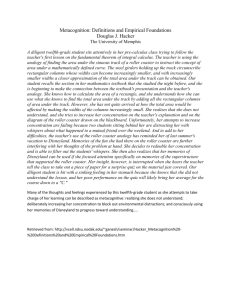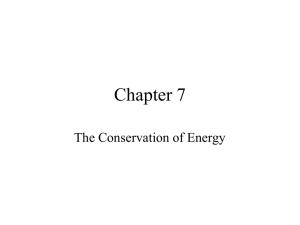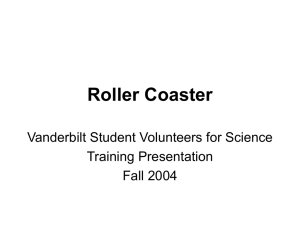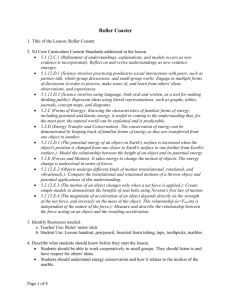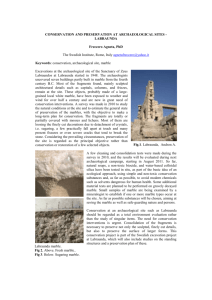Roller Coaster Conservation
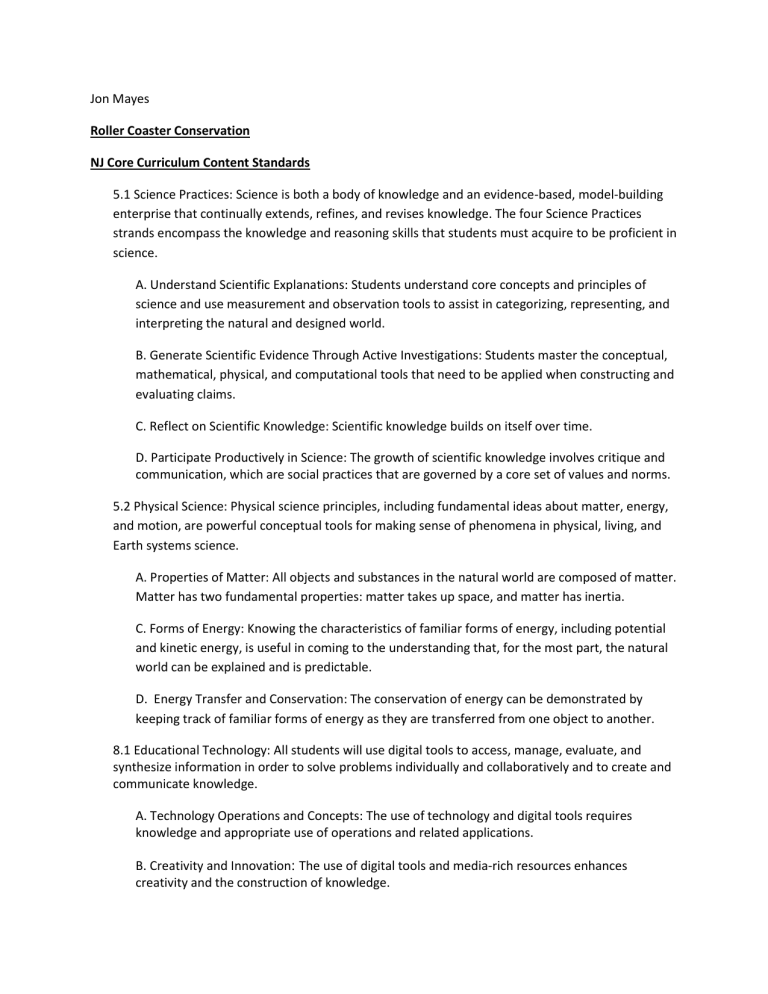
Jon Mayes
Roller Coaster Conservation
NJ Core Curriculum Content Standards
5.1 Science Practices: Science is both a body of knowledge and an evidence-based, model-building enterprise that continually extends, refines, and revises knowledge. The four Science Practices strands encompass the knowledge and reasoning skills that students must acquire to be proficient in science.
A. Understand Scientific Explanations: Students understand core concepts and principles of science and use measurement and observation tools to assist in categorizing, representing, and interpreting the natural and designed world.
B. Generate Scientific Evidence Through Active Investigations: Students master the conceptual, mathematical, physical, and computational tools that need to be applied when constructing and evaluating claims.
C. Reflect on Scientific Knowledge: Scientific knowledge builds on itself over time.
D. Participate Productively in Science: The growth of scientific knowledge involves critique and communication, which are social practices that are governed by a core set of values and norms.
5.2 Physical Science: Physical science principles, including fundamental ideas about matter, energy, and motion, are powerful conceptual tools for making sense of phenomena in physical, living, and
Earth systems science.
A. Properties of Matter: All objects and substances in the natural world are composed of matter.
Matter has two fundamental properties: matter takes up space, and matter has inertia.
C. Forms of Energy: Knowing the characteristics of familiar forms of energy, including potential and kinetic energy, is useful in coming to the understanding that, for the most part, the natural world can be explained and is predictable.
D. Energy Transfer and Conservation: The conservation of energy can be demonstrated by keeping track of familiar forms of energy as they are transferred from one object to another.
8.1 Educational Technology: All students will use digital tools to access, manage, evaluate, and synthesize information in order to solve problems individually and collaboratively and to create and communicate knowledge.
A. Technology Operations and Concepts: The use of technology and digital tools requires knowledge and appropriate use of operations and related applications.
B. Creativity and Innovation : The use of digital tools and media-rich resources enhances creativity and the construction of knowledge.
E. Research and Information Literacy : Effective use of digital tools assists in gathering and managing information.
F. Critical Thinking, Problem Solving, and Decision-Making : Information accessed through the use of digital tools assists in generating solutions and making decisions.
8.2 Technology Education, Engineering, and Design: All students will develop an understanding of the nature and impact of technology, engineering, technological design, and the designed world, as they relate to the individual, global society, and the environment.
B. Design: Critical Thinking, Problem Solving, and Decision-Making: The design process is a systematic approach to solving problems.
Equipment
PVC insulation tubes, tape, toothpicks, marbles, rulers
What Students Should Know Before The Lesson
Before the lesson students should know about conservation of energy and energy transfer. I will formatively assess this by walking around and observing their treatment and methods behind building their roller coasters. If they do not seem to be employing conservation of energy into their design, I will ask them questions like, “How do you know how high to make the initial hill?” Students should also know and be able to apply circular motion, central forces, Newton’s second law. Lastly, students should be familiar with all aspects of the engineering design process.
Lesson Objectives, Goals, Important Ideas, and How I Will Assess Them
The purpose of this lesson in terms of procedure and understanding is for students to apply their knowledge of gravitational potential energy, conservation of energy, transfer of energy, Newton’s
2 nd law, and circular motion to a design project wherein they build a roller coaster. They must find the largest possible loop for a certain height of initial drop where the marble must be in constant contact with the track.
Students must master the idea that energy must be conserved so the initial gravitational potential energy is the maximum amount of energy the marble has. Work can be done on the marble through heating or change in internal energy. Keeping this in mind they must design a vertical loop in the track so there is just enough kinetic energy to ensure a central force will be exerted on the marble to keep it on the track.
Also, students must meta-cognitively reflect on their reasoning, thought processes, and decisions during the activity and relate this to respective forms of engineering. They must think about what kinds of engineers would be necessary for a project like this. Lastly, I want them to compare the scientific process to the engineering process and think about why they are different or similar in certain ways.
I will formatively assess them by making rounds in the room and asking them questions which will guide and broaden their thought processes during the activity. Also, I will read and make comments on their reports so they can read my comments, reflect on them, and revise the report for resubmission.
Potential Student Difficulties
Students may have trouble with the transfer of energy, conservation of energy, and how to relate kinetic energy with velocity. Also, they may have trouble conceptualizing how a central force will keep the marble on the track through the creation of a Newton’s-third-law-pair centrifugal force. The students may have trouble identifying the types of engineers required to work on a full-scale project like this.
The Lesson
Application Experiment: Roller Coaster Conservation
Equipment: PVC insulation tubes, tape, toothpicks, marbles, rulers
Experiment: Create a roller coaster with a large, vertical loop. Try to make the largest loop possible. You get 10 points added to your equipment cost for every piece of tubing used, 1 point for each foot of tape, and 1 point for each toothpick. The ideas we are using in this application experiment are conservation of energy, energy transfer, and central forces. Your coaster’s score is given by
Coaster Quality Quantity =
𝐿𝑜𝑜𝑝 𝐷𝑖𝑎𝑚𝑒𝑡𝑒𝑟 𝑖𝑛 𝐼𝑛𝑐ℎ𝑒𝑠
𝐸𝑞𝑢𝑖𝑝𝑚𝑒𝑛𝑡 𝐶𝑜𝑠𝑡
The highest CQQ wins!
Before bell Prep and sit down.
Reading and mentally preparing for Greeting and finishing set up for the activity. equipment.
0-5 min
5-40 min
Activity Intro
Roller Coaster
Conservation
Listening
Doing the activity
Explaining and introducing the activity
Walking around monitoring the students, helping them, and keeping them motivated.
40-45 min HW Listening
Explaining to them what they must write up in the lab report for homework.
Homework: Create a formal lab report for this experiment. Include the full scientific method for this type of experiment. Include a derivation of how you decided on the height of the loop. At the end of
your lab report I want you to discuss which parts of this activity were science and which were engineering. Think about who would be needed on a large scale project like this in terms of scientists and engineers.
Modifications for Different Learners
This activity incorporates creating, design, building, measuring, analyzing, applying, and performing so it has a desirable aspect for most types of learners.
